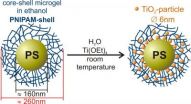(Press-News.org) Cell therapy is a promising alternative to tissue and organ transplantation for diseases that are caused by death or poor functioning of cells. Considering the ethical discussions surrounding human embryonic stem cells, a lot is expected of the so-called 'induced pluripotent stem cells' (iPS cells). However, before this technique can be applied effectively, a lot of research is required into the safety and efficacy of such iPS cells. VIB scientists associated to the UGent have developed a mouse model that can advance this research to the next step.
Lieven Haenebalcke (VIB/UGent): "iPS cells have enormous therapeutic potential, but require more thorough testing before they can be used for such purposes. Using our new mouse model, we can study which mechanisms determine the identity of a cell. This knowledge is essential before we can use cell therapy for regenerative medicine."
Jody Haigh (VIB/UGent): "If we want to give cell therapy a future, then we must continue this type of research and invest in the further development of such technologies. This will result in an improved insight into cellular identity and – in the long term – safer options of applying iPS cells or cells derived from iPS cells in clinical studies."
Cell therapy – replacing cells to provide a cure
Cell therapy is the replacement of lost or poorly functioning cells in patients. For example, such cell therapies could be used to repair the heart muscle after a heart attack, joints affected by arthritis, the pancreas in diabetes or the spine in certain forms of paralysis. This requires cells that are able to multiply in the laboratory and that can be converted to healthy cells of the desired cell type. Human embryonic stem cells meet these criteria, but they are ethically controversial.
iPS cells – a promising alternative to embryonic stem cells
Shinya Yamanaka recently developed a fairly simple method to reprogram differentiated cells – such as skin cells – back to stem cells, so-called "induced pluripotent stem cells" (iPS cells). This earned him the Nobel Prize for Medicine in 2012 (shared with John Gurdon). These iPS cells can be generated using only 4 "reprogramming factors".
As is the case with embryonic stem cells, these iPS cells can be used to produce other cell types, such as heart muscle cells or nerve cells. They can also be cultured indefinitely and there are no ethical objections as they are not obtained from human embryos left over after IVF, but from adult individuals. Furthermore, iPS cells are obtained from the patient and this reduces the risk of rejection during therapeutic applications.
Essential research possible
Before iPS cells can be used effectively and safely as a therapy, it is essential that we gain clear insight into which molecular mechanisms determine the identity of a cell; why and how a cell develops into – for example – a heart muscle cell, a nerve cell or a blood cell. In order to do so, Lieven Haenebalcke and Jody Haigh have developed a mouse model that will enable them to conduct this research. They succeeded in creating iPS cells from a variety of mouse cells. Furthermore, the new model allows the investigators to replace the 4 reprogramming factors in these iPS cells efficiently with specific genes in order to create targeted different cell types, such as functional heart muscle cells.
Lieven Haenebalcke (VIB/UGent): "It enables us to study in a relatively simple manner the molecules that play a role in the formation and the identity of various cell types. Using this knowledge, we can then manipulate the identity of cells in a more targeted fashion and then conduct pre-clinical tests to determine whether these new cells are suitable, for example to repair heart tissue or blood vessels."
### END
Cell therapy a little more concrete thanks to VIB research
2013-02-21
ELSE PRESS RELEASES FROM THIS DATE:
VHA plays leading role in health information technology implementation and research
2013-02-21
Philadelphia, Pa. (February 21, 2013) - The Veterans Health Administration (VHA) is aiming to become a leader in using health information technology (HIT) to change the way patients experience medical care, to decrease medical mistakes, and to improve health outcomes. A special March supplement of Medical Care highlights new research into the many and varied types of HIT projects being explored to improve the quality of patient care throughout the VHA system. Medical Care is published by Lippincott Williams & Wilkins, a part of Wolters Kluwer Health.
The special issue ...
Antibacterial protein's molecular workings revealed
2013-02-21
On the front lines of our defenses against bacteria is the protein calprotectin, which "starves" invading pathogens of metal nutrients.
Vanderbilt investigators now report new insights to the workings of calprotectin – including a detailed structural view of how it binds the metal manganese. Their findings, published online before print in the Proceedings of the National Academy of Sciences, could guide efforts to develop novel antibacterials that limit a microbe's access to metals.
The increasing resistance of bacteria to existing antibiotics poses a severe threat to ...
When water speaks
2013-02-21
Why certain catalyst materials work more efficiently when they are surrounded by water instead of a gas phase is unclear. RUB chemists have now gleamed some initial answers from computer simulations. They showed that water stabilises specific charge states on the catalyst surface. "The catalyst and the water sort of speak with each other" says Professor Dominik Marx, depicting the underlying complex charge transfer processes. His research group from the Centre for Theoretical Chemistry also calculated how to increase the efficiency of catalytic systems without water by ...
Sniffing out the side effects of radiotherapy may soon be possible
2013-02-21
Researchers at the University of Warwick and The Royal Marsden NHS Foundation Trust have completed a study that may lead to clinicians being able to more accurately predict which patients will suffer from the side effects of radiotherapy.
Gastrointestinal side effects are commonplace in radiotherapy patients and occasionally severe, yet there is no existing means of predicting which patients will suffer from them. The results of the pilot study, published in the journal Sensors, outline how the use of an electronic nose and a newer technology, FAIMS (Field Asymmetric ...
Titanium dioxide nanoreactor
2013-02-21
This press release is available in German.
Now, Dr. Katja Henzler and a team of chemists at the Helmholtz Centre Berlin have developed a synthesis to produce nanoparticles at room temperature in a polymer network. Their analysis, conducted at BESSY II, Berlin's synchrotron radiation source, has revealed the crystalline structure of the nanoparticles. This represents a major step forward in the usage of polymeric nanoreactors since, until recently, the nanoparticles had to be thoroughly heated to get them to crystallize. The last synthesis step can be spared due ...
Wanted: A life outside the workplace
2013-02-21
EAST LANSING, Mich. — A memo to employers: Just because your workers live alone doesn't mean they don't have lives beyond the office.
New research at Michigan State University suggests the growing number of workers who are single and without children have trouble finding the time or energy to participate in non-work interests, just like those with spouses and kids.
Workers struggling with work-life balance reported less satisfaction with their lives and jobs and more signs of anxiety and depression.
"People in the study repeatedly said I can take care of my job demands, ...
Research discovers gene mutation causing rare eye disease
2013-02-21
New Orleans, LA – Research conducted by Dr. Jayne S. Weiss, Professor and Chair of Ophthalmology at LSU Health Sciences Center New Orleans, and colleagues has discovered a new mutation in a gene that causes Schnyder corneal dystrophy (SCD.) The gene was found to be involved in vitamin K metabolism suggesting the possibility that vitamin K may eventually be found useful in its treatment. The findings are published in the February 2013 issue of the peer-reviewed journal, Human Mutation.
Schnyder corneal dystrophy is a rare hereditary eye disease that results in progressive ...
City layout key to predicting riots
2013-02-21
In the future police will be able to predict the spread of riots, and how they impact on cities, thanks to a new computer model.
Developed by researchers at UCL, the model highlights the importance of considering the layout of cities in order for police to suppress disorder as quickly as possible once a riot is in progress.
"As riots are rare events it is difficult to anticipate if and how they will evolve. Consequently, one of the main strategic issues that arose for the police during the 2011 London riots concerned when and where to deploy resources and how many ...
Rutgers neuroscientist sheds light on cause for 'chemo brain'
2013-02-21
It's not unusual for cancer patients being treated with chemotherapy to complain about not being able to think clearly, connect thoughts or concentrate on daily tasks. The complaint – often referred to as chemo-brain – is common. The scientific cause, however, has been difficult to pinpoint.
New research by Rutgers University behavioral neuroscientist Tracey Shors offers clues for this fog-like condition, medically known as chemotherapy-induced cognitive impairment. In a featured article published in the European Journal of Neuroscience, Shors and her colleagues argue ...
Mercury may have harbored an ancient magma ocean
2013-02-21
CAMBRIDGE, MA -- By analyzing Mercury's rocky surface, scientists have been able to partially reconstruct the planet's history over billions of years. Now, drawing upon the chemical composition of rock features on the planet's surface, scientists at MIT have proposed that Mercury may have harbored a large, roiling ocean of magma very early in its history, shortly after its formation about 4.5 billion years ago.
The scientists analyzed data gathered by MESSENGER (MErcury Surface, Space ENvironment, GEochemistry, and Ranging), a NASA probe that has orbited the planet since ...

